
The noble Roman house
Since the name of the family that lived in the house is unknown, it takes the name from the statue of a Faunus which is in the "atrium". A characteristic of this house is that it contains two "peristilium", but today only the atrium remains with the "impluvium".
The Dioscuri
The Dioscuri were the sons of Zeus, together with the daughter Elena. They had been conceived by Leda who had been transformed into a swan.the Dioscuri were Greek gods that always undertook all their missions together. Castore was a horse-tamer. Polluce was an excellent boxer. Both were considered to be divine saviours especially during battle. The Gemini constellation was named after them: they were also considered the saviours of seamen. Amongst some of their bravest actions, the most commonly known are: the freeing of their sister Elena that had been kidnapped when she was ten by Teseo, taking part in the expedition of the Argonauti, hunting the wild boar Calidonio and the kidnapping of the Leucopidi (Ilaria and Fede) in which Castore was killed. Polluce begged his father Zeus to let him die as well: however, Zeus allowed him to give up half of his immortality so his brother could live again but they had to take turns to live a day on the Olimpo and the other in the Kingdom of Death. The Dioscori were also worshipped by the Romans and according to a legend in the battle of Lake Regillo (499 or 496 BC) between the Romans and the Tuscolani (allies of the Tarquini), the Dioscuri guided the Romans to victory who in turn went to the Roman Forum and announced their victory to the crowds. Then they took their white horses down to the Mount Palatino to drink at Giunturna's Springs. In Rome the annual festivity in honour of the Dioscuri was celebrated on July 15th, the anniversary of the battle. The Romans swore aon the names of the Dioscuri when asked to tell the truth: the women swore in the name of Castore, and the men in the name of Polluce. The "ausica" art usually represents Castore and Polluce nude, with a hammer behind their shoulders and on their heads they usually wear a coned shaped hat "pilos" with a star on the top. In their hands they have a spear. They are usually represented on or next to a horse and holding its bridal. The Dioscuri that are visible today in Rome at the top of the steps which lead to the Piazza del Campidoglio, date back to the late Imperial era and can also be found at the bottom of the Obelisk in Piazza del Quirinale.
Example of a luxury dwelling. The most striking features are the frescos showing "Lararia" (Lari were the family defenders) and mythological scenes depicting Hercules, Theseus and Ariadne and Minos.
Dyonisus
Dionysus, the son of Zeus and Semele, was the god of nature, vegetation and above all grapevines, the plant that he had discovered and made known to man together with the secret of how to extract tonific juice. From the time he was small, Dionisus had a busy life, so to protect him from Juno, Zeus turned him into a goat and gave him to the nymphs who brought him up with great care. When Dionysus became an adult, he gave the juice he had extracted from the grapes to his friends (the Satyrs and the Muses) and they became a happy and lively group, so Dionysus traveled from place to place to let everyone know about the drink that produced joy and happiness. On his pilgrimage, Dionysus had lots of adventures, while he was traveling around the Archipelago islands in Greece he met Ariadne in Naxos, a beautiful girl who was very upset because while she was asleep, the thankless Theseus had abandoned her even though she had helped him escape from the labyrinth.
 The noble Roman house had a large central structure which was locally called "Atrium"; the "Compluvium" was used to sun and air the house and was set in the ceiling.
The rain that fell through the "Impluvium" was channelled into a large tank, which intern was connected to a personal cistern. Lots of rooms were situated around the atrium. Situated behind the atrium was the "Tablinum", a study where the master of the house would work. Opening out from this room was a column garden called "Peristilium".
The noble Roman house had a large central structure which was locally called "Atrium"; the "Compluvium" was used to sun and air the house and was set in the ceiling.
The rain that fell through the "Impluvium" was channelled into a large tank, which intern was connected to a personal cistern. Lots of rooms were situated around the atrium. Situated behind the atrium was the "Tablinum", a study where the master of the house would work. Opening out from this room was a column garden called "Peristilium".
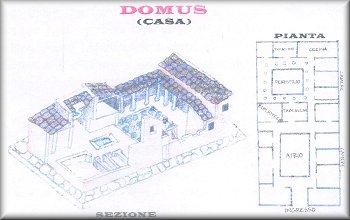 The majority of the Roman population lived in "insulae", comparable with modern day apartment blocks: the houses had up to 5 floors but did not have running water or toilets, and of course no electricity; in that period there was no glass, so the windows were closed with animal skins, wood and other materials to stop the cold, but this also meant there was no natural light, this is the reason why the majority of the Romans spent their time in the public areas such as "public baths" and "forums".
The majority of the Roman population lived in "insulae", comparable with modern day apartment blocks: the houses had up to 5 floors but did not have running water or toilets, and of course no electricity; in that period there was no glass, so the windows were closed with animal skins, wood and other materials to stop the cold, but this also meant there was no natural light, this is the reason why the majority of the Romans spent their time in the public areas such as "public baths" and "forums".
The house of Loreio Tiburtino
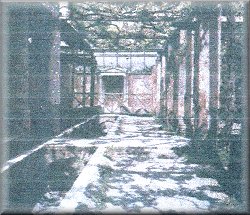 The house of Loreio Tiburtino had two phases of construction: the entrance dates back to the "Samnite" period, the second and central courtyard (Peristilium) dates back to the Imperial period. Set in the "Peristilium" is a beautiful garden with a gallery and pergola rich with small water channels and fountains. The garden is decorated with paintings and sculptures plus a temple, a sign of the wealth of the family that lived there. Inside the house we can find mythical figures painted on the walls, one of which shows "Narcissus" looking at his reflection in the water, and another scene that represents the mythical tale of "Pyramus and Thisbe".
The house of Loreio Tiburtino had two phases of construction: the entrance dates back to the "Samnite" period, the second and central courtyard (Peristilium) dates back to the Imperial period. Set in the "Peristilium" is a beautiful garden with a gallery and pergola rich with small water channels and fountains. The garden is decorated with paintings and sculptures plus a temple, a sign of the wealth of the family that lived there. Inside the house we can find mythical figures painted on the walls, one of which shows "Narcissus" looking at his reflection in the water, and another scene that represents the mythical tale of "Pyramus and Thisbe".
Pyramus and Thisbe
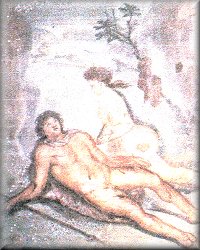 The legend of "Pyramus and Thisbe" was born in central Asia. To be precise in Babylon. The most important element in this story is a Jasmine tree. Pyramus and Thisbe, two beautiful children are the main characters in the legend. The parents, who hated each other for many years did not let them meet. However, the love between them grew thanks to the goddess Aphrodite that whispered in Pyramus' ear that he should declare his love to Thisbe. The same night, the goddess went to Thisbe's house and told Thysbe about Pyramus' love for her. In the following days when they met, they exchanged longing looks and affectionate words. Despite being forbidden to meet by their parents they arranged to meet under a Jasmine tree. While Thisbe was waiting for Pyramus who was late, a lion covered in blood (because it had eaten a gazelle) arrived. Thisbe was scared by the lion and hid in a grotto. But while she was hiding, she lost her cape. The lion grabbed the cape and stained it with blood. So when Pyramus arrived and recognized the cape, he thought that Thisbe had been eaten by the lion. In a moment of anguish thinking he had lost his love, he plunged a dagger into his chest taking his own life. When Thisbe left the grotto and came back to the Jasmine tree she saw that Pyramus was dead and in desperation she took her own life. From that day forth it is said that the Jasmine tree turned red with the blood of the two young lovers. It is also said that William Shakespeare was inspired to write Romeo & Juliet after reading this legend.
The legend of "Pyramus and Thisbe" was born in central Asia. To be precise in Babylon. The most important element in this story is a Jasmine tree. Pyramus and Thisbe, two beautiful children are the main characters in the legend. The parents, who hated each other for many years did not let them meet. However, the love between them grew thanks to the goddess Aphrodite that whispered in Pyramus' ear that he should declare his love to Thisbe. The same night, the goddess went to Thisbe's house and told Thysbe about Pyramus' love for her. In the following days when they met, they exchanged longing looks and affectionate words. Despite being forbidden to meet by their parents they arranged to meet under a Jasmine tree. While Thisbe was waiting for Pyramus who was late, a lion covered in blood (because it had eaten a gazelle) arrived. Thisbe was scared by the lion and hid in a grotto. But while she was hiding, she lost her cape. The lion grabbed the cape and stained it with blood. So when Pyramus arrived and recognized the cape, he thought that Thisbe had been eaten by the lion. In a moment of anguish thinking he had lost his love, he plunged a dagger into his chest taking his own life. When Thisbe left the grotto and came back to the Jasmine tree she saw that Pyramus was dead and in desperation she took her own life. From that day forth it is said that the Jasmine tree turned red with the blood of the two young lovers. It is also said that William Shakespeare was inspired to write Romeo & Juliet after reading this legend.
Echo and Narcissus
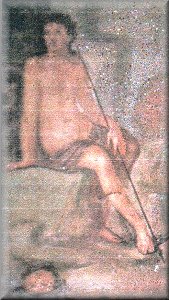 The legend talks about a twin brother and sister Narcissus and Altamene that looked so similar they were like two drops of water. The twins had a very close relationship but sadly one day Altamene fell sick and died leaving Narcissus alone and desparate. One day while Narcissus was walking in the woods he came across a stream and stopped to drink. While he was drinking he saw his reflection in the water and thought that it was his sister. He spoke to his sister (his reflection). And so he returned every day to speak to her. The nymph Echo saw Narcissus by the stream and fell in love with him. She tried to console him but he would not listen. For days and days Narcissus remained fixed by his reflection, caught in an evil spell. He lost weight and became worn out. Echo didn't want to leave the young boy to his unhappy destiny, so not far away she kept anxiously watch over him until the day he died and transformed into a white flower which still has the name Narcissus. The nymph ran out from the shadows and over to the flower calling in a desperate voice "Narcissus, Narcissus" and then with great leaps returned to the woods to wander aimlessly for days dying of pain. Zeus could not help the nymph but he showed her pity and said in a thundering voice "Let the voice of the gentle nymph Echo remain so the world can hear her forever and ever".
The legend talks about a twin brother and sister Narcissus and Altamene that looked so similar they were like two drops of water. The twins had a very close relationship but sadly one day Altamene fell sick and died leaving Narcissus alone and desparate. One day while Narcissus was walking in the woods he came across a stream and stopped to drink. While he was drinking he saw his reflection in the water and thought that it was his sister. He spoke to his sister (his reflection). And so he returned every day to speak to her. The nymph Echo saw Narcissus by the stream and fell in love with him. She tried to console him but he would not listen. For days and days Narcissus remained fixed by his reflection, caught in an evil spell. He lost weight and became worn out. Echo didn't want to leave the young boy to his unhappy destiny, so not far away she kept anxiously watch over him until the day he died and transformed into a white flower which still has the name Narcissus. The nymph ran out from the shadows and over to the flower calling in a desperate voice "Narcissus, Narcissus" and then with great leaps returned to the woods to wander aimlessly for days dying of pain. Zeus could not help the nymph but he showed her pity and said in a thundering voice "Let the voice of the gentle nymph Echo remain so the world can hear her forever and ever".
The house of the Faunus
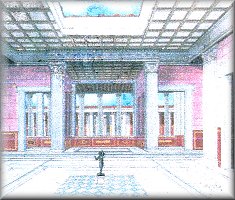
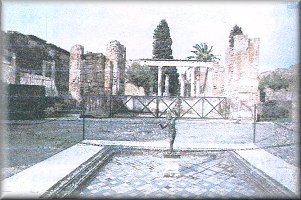
The house of Dioscuri
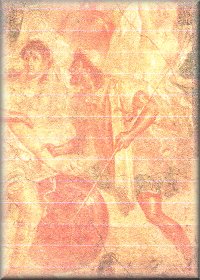 This house takes it name from the fresco, which is in the entrance hall depicting the Dioscuri: Castore and Polluce.
This house takes it name from the fresco, which is in the entrance hall depicting the Dioscuri: Castore and Polluce.
The house of the Vettiis
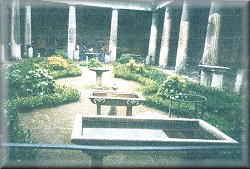
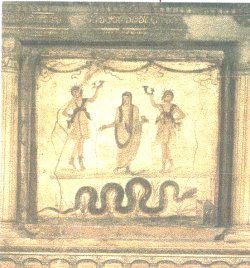
The house of Mysteries
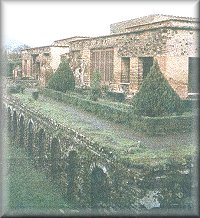 The name "Villa dei Misteri" is used because of the frescos (some of the best preserved) showing the beginning of the "Dionysiaca".
The name "Villa dei Misteri" is used because of the frescos (some of the best preserved) showing the beginning of the "Dionysiaca".
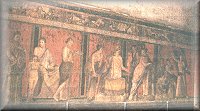 Dionysus married Ariadne and the inseparable couple became a symbol of eternal joy and neverending happiness. In Lidia, Dyonisus met King Midas and asked him to find his old teacher Sileno and in return he would grant him his every wish. Midas wished that everything he touched would turn into gold, but this was a tragic error because Midas realized that even if he became rich he would not be able to eat (because everything he touched turned into gold) so he would die. King Midas went back to Dionysus and asked Dionysus to return him to normality and his wish was granted again.
Dionysus married Ariadne and the inseparable couple became a symbol of eternal joy and neverending happiness. In Lidia, Dyonisus met King Midas and asked him to find his old teacher Sileno and in return he would grant him his every wish. Midas wished that everything he touched would turn into gold, but this was a tragic error because Midas realized that even if he became rich he would not be able to eat (because everything he touched turned into gold) so he would die. King Midas went back to Dionysus and asked Dionysus to return him to normality and his wish was granted again.